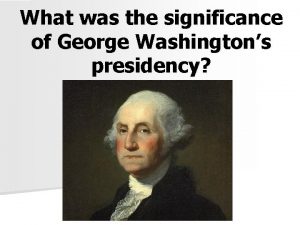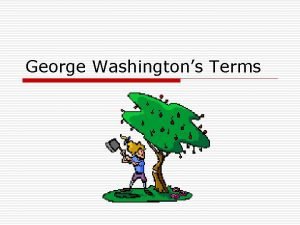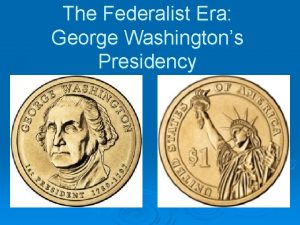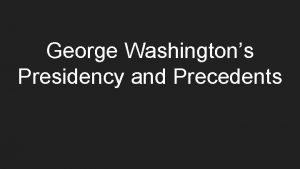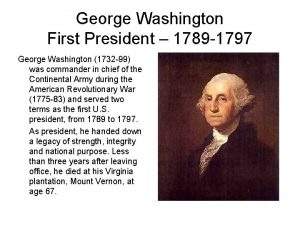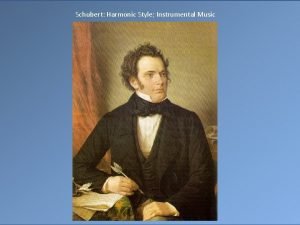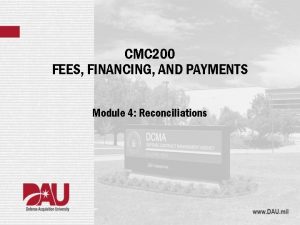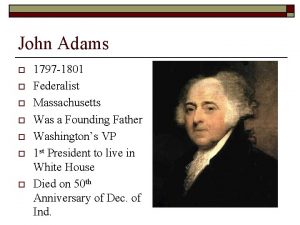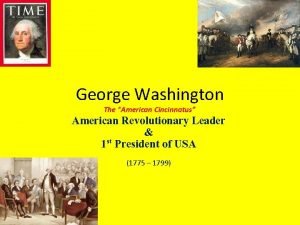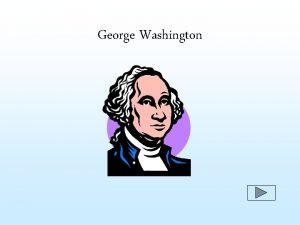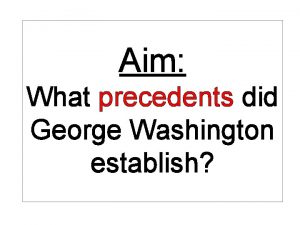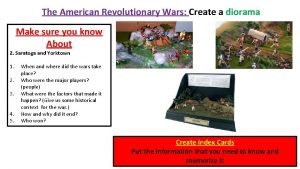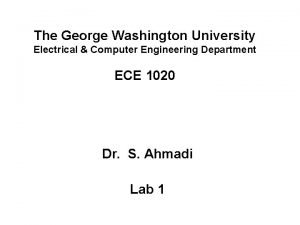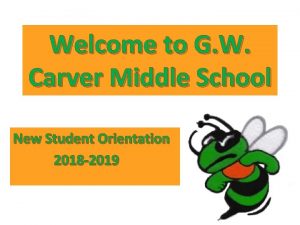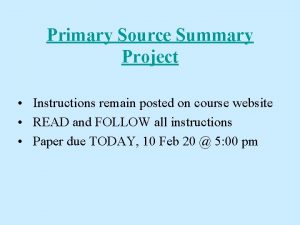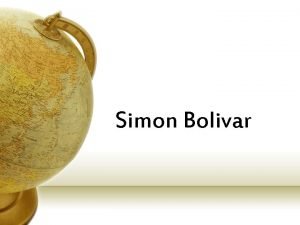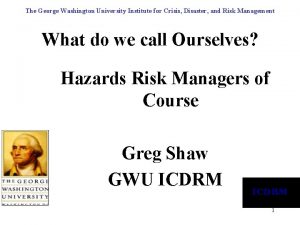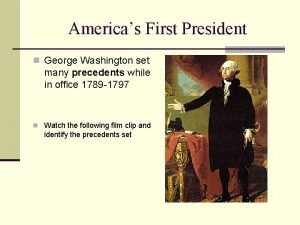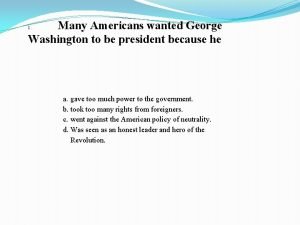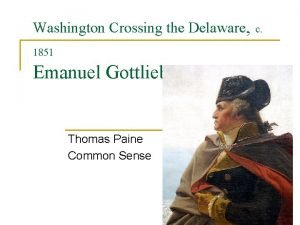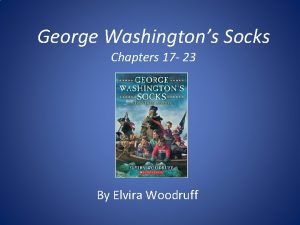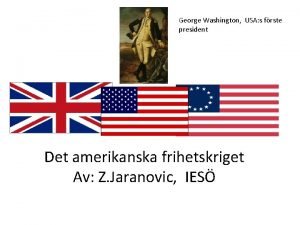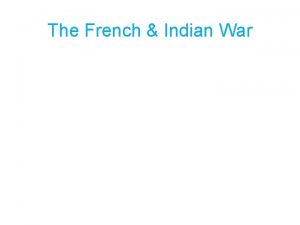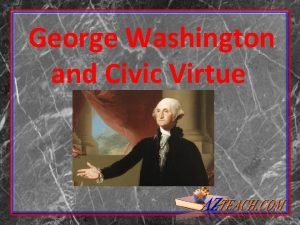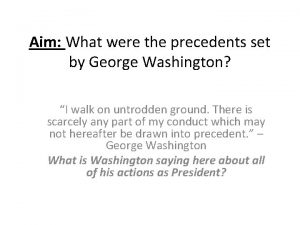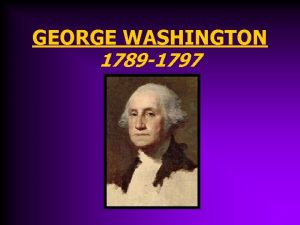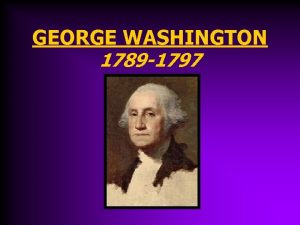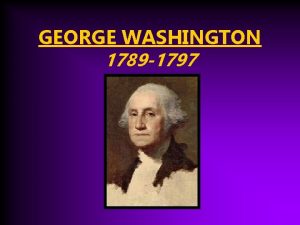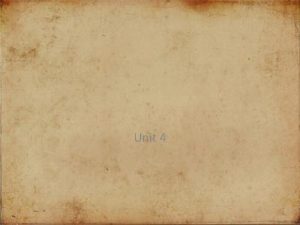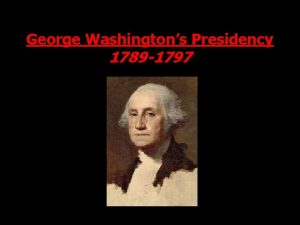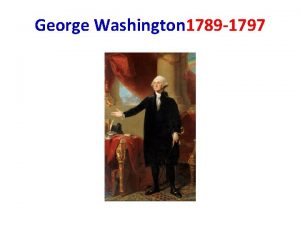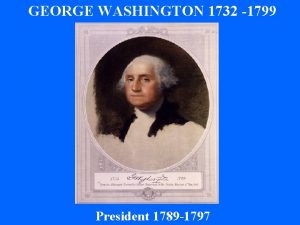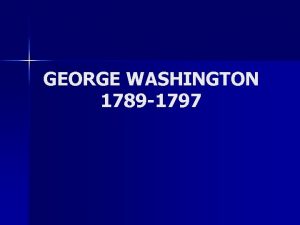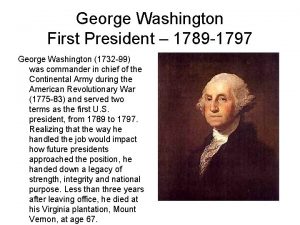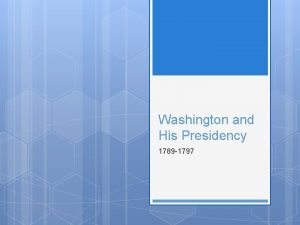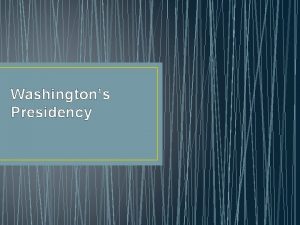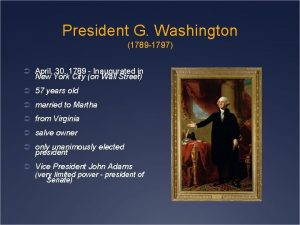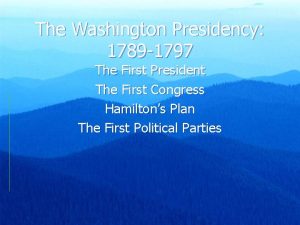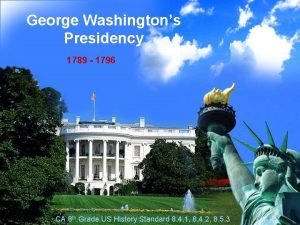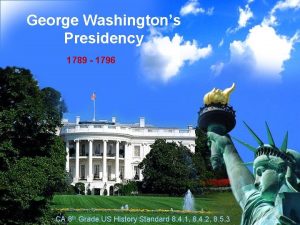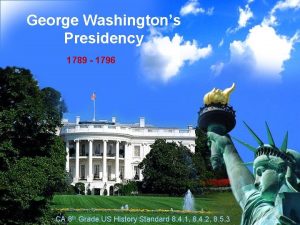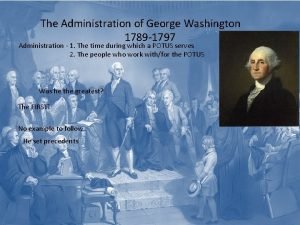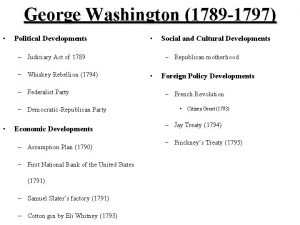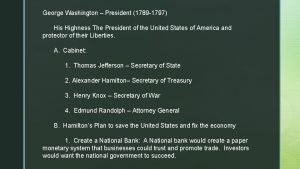GEORGE WASHINGTON 1789 1797 George Washingtons Presidency April





































- Slides: 37

GEORGE WASHINGTON 1789 -1797

George Washington’s Presidency • April 30, 1789 Washington (Virginia) is inaugurated (sworn in) as President. John Adams (Mass. ) becomes the Vice. President.

George Washington’s Presidency • Washington establishes many governmental precedents. PRCEDENT: an example that would become a standard practice.

4 Problems facing the New Nation 1. 2. 3. 4. Economy Political Division Unrest French Revolution

Executive Departments • Congress created three executive departments and Washington got to choose the heads of those depts. • Washington began meeting regularly with the heads of the departments • For advice and assistance • First Cabinet

Presidential Cabinet • The First Presidential Cabinet • Secretary of State – Thomas Jefferson • oversee the relations between the U. S. and other countries. • Secretary of War – Henry Knox • oversee the nation’s defenses. • Secretary of Treasury – Alexander Hamilton • to manage the government’s money. • Attorney General - Edmond Randolph • to advise the government on legal matters.

Judicial Branch • Judiciary Act of 1789 – created federal court system with 3 levels • Established District and Appellate Courts • Set the number of Supreme Court Justices at 6 • 1 chief Justice • 5 associate justices • There are 9 today: A sixth associate was added in 1807, a seventh and eighth in 1837, and a ninth in 1863. • Also created executive department of Justice and Attorney General • to advise the government on legal matters. • Edmund Randolph joined cabinet Edmund Randolph – 1 st Attorney General

Alexander Hamilton • Only Immigrant Founding Father • British West Indies • Father left and mother died • Worked in the shipping business as a clerk • Operated the business as a teen when owner was away • Sent to New York for education • Joined Continental Army • Was the aide to Washington during the American Revolution • Became lawyer • Financial Genius • Completely shaped US Financial System

1. Economy Alexander Hamilton’s Financial Plan

Supply and Demand • What is the relationship between supply and demand? • How does the relationship between supply and demand impact the value of goods, services, etc. ?

Inflation • Economic condition in which too much money is in circulation resulting in an increase in the price of goods and services thus decreasing the value of money

Deflation • Economic condition in which not enough money is in circulation resulting in a decrease in the price of goods and services thus increasing the value of money

Hard Money • precious metal such as gold and silver • also known as “Specie” • why is hard money inherently deflationary?

Soft money • paper currency that is backed by something of value like precious metal • why is soft money inherently inflationary?

Hamilton’s Financial Plan NOTE: Alexander Hamilton believed that the federal government should be stronger than the state governments.

Alexander Hamilton and US Financial Policy 1. Pay off foreign war debt immediately and in full • $11. 7 Million (owed mostly to France) • Only way to create confidence in new nation

Alexander Hamilton and US Financial Policy 2. Buy back depreciated Revolutionary war bonds at face value • US owed $40 million to citizens in war bonds • Only way to establish trust in new nation • Government must do what it said it would • Jefferson opposed plan • Rewarded speculators at the expense of the poor

Alexander Hamilton and US Financial Policy 3. Assume State’s war debt • • • $25 million dollar debt Would establish a federal line of credit Tie all states to Federal Government Establish support for Federal Government Help national economy by freeing up states’ money

Alexander Hamilton and US Financial Policy 4. Create Bank of the United States • Bank for Government money and loans • 20 year charter • Believed that the “necessary and proper” clause gave Congress power to charter Bank • Article 1 sect. 8 clause 18 • The Congress shall have Power. . . To make all Laws which shall be necessary and proper for carrying into Execution the foregoing Powers, and all other Powers vested by this Constitution in the Government of the United States, or in any Department or Officer thereof. • Helped US consolidate its debt and pay its creditors • Offered stability to the US economy

2. Political Division Rise of Political Parties: Hamilton vs. Jefferson

The Rise of Political Parties • Political Parties – groups of people with similar political views • During the ratification fight, 2 different groups emerged, Federalists and Anti-Federalists • Washington chose members of both parties to serve with him • Was a strong figure that unified both parties • Neither side wanted to be against Washington

Debate on Interpretation of the Constitution • STRICT CONSTRUCTION: only what the Constitution clearly states – favored by Jefferson and Madison. • LOOSE CONSTRUCTION: the Constitution should be flexible to meet the needs of the country (Elastic Clause) – favored by Hamilton and Adams. v. Jefferson and Hamilton argue these points on the creation of the National Bank.

Hamilton vs. Jefferson • Political parties first emerged when followers of Alexander Hamilton and Thomas Jefferson disagreed over major issues on the Constitution and government. • Jefferson’s group took the name Democratic-Republicans. Due to experience with Britain, they feared a powerful central government. They wanted the states to hold greater power. • Hamilton championed a strong national government with a powerful chief executive. His followers called themselves Federalists, after those who supported the Constitution.

The Rise of Political Parties • Federalists – favored the • Anti-Federalists (also known as Constitution, and a strong Democratic-Republicans, or Republicans) – central government originally opposed the • Alexander Hamilton Constitution, favored strong state government • Thomas Jefferson

3. Domestic Policy Unrest: Natives & Citizens ?

Washington’s Domestic Policy Northwest Territory • Americans continued to settle in the Ohio Country north of the Ohio River • British had ceded land to US after Rev. war • Indians rallied around Little Turtle and went to war against settlers • Indians felt land was theirs despite treaties • Were supplied by British • Washington sent General “Mad” Anthony Wayne to end the dispute

Washington’s Domestic Policy Battle of Fallen Timbers • August 20, 1794 • Near Toledo, Ohio • Wayne and his men chased the Indians back to Fort Miami • British refused Indians access – did not want to start another war • Americans routed Indians, burning their fields and villages • Led to Treaty of Greenville in 1795 • Indians gave Americans most of Ohio, Chicago, Detroit • Americans gave Indians $20, 000 worth of goods and acknowledged existing claims

Battle of Fallen Timbers

Washington’s Domestic Policy The Whiskey Rebellion • Congress passed excise tax on American made Whiskey in 1791 • To pay off national debt • Pennsylvania farmers who couldn’t pay the tax rebelled • Tarred and feathered tax collectors • Skirmishes broke out between rebels and Federal officers • Shots fired Rebels tarring and feathering a tax collector during the Whiskey Rebellion

Washington’s Domestic Policy The Whiskey Rebellion • Washington personally commanded nearly 13, 000 troops to shut down the rebellion • Most Rebels fled without battle • Washington captured 20 • First major show of Federal Authority, Force • Washington WOULD see that the laws were executed • set a precedent that U. S. citizens who wished to change the law had to do so peacefully through constitutional means

CRASH COURSE • https: //www. youtube. com/watch? v=r 161 c. LYzu. DI&index=9&list=PL 8 d. Puua. Lj. Xt. Mwmep. Bj. TSG 593 e. G 7 Obz. O 7 s

? 4. Foreign Diplomacy FRENCH REVOLUTION, SPAIN & BRITAIN

Washington’s Foreign Policy: France • The French Revolution started in 1789 • Storming of the Bastille • French uprising against monarchy of Louis XVI caused considerable violence and bloodshed • The noble ideas of liberty, freedom, and the rights of man which started the revolution would turn to fear and tyranny • “Reign of Terror” • Mass executions of enemies of the Revolution (18 -40, 000) • This revolution would renew French hostilities with Britain • Jefferson and the Anti-Federalists sided with the French and their push towards individual rights • "The tree of liberty must be refreshed from time to time with the blood of patriots and tyrants. It is natural manure. " - Thomas Jefferson • Mob violence scared Hamilton, Federalists • Preferred the stability and order of Britain • Neutrality Proclamation • Did not want to take sides in regards to French Revolution • Washington pursued a friendly and impartial conduct between the two nations

Washington’s Foreign Policy: Britain • British still had not evacuated western forts • Were using them to supply Indians on raids against American settlers • Britain wanted to eliminate American Trade with the French • British capturing neutral American merchant ships in the French West Indies • Jay’s Treaty • Chief Justice John Jay was sent to Britain to negotiate treaty with British • Both sides received some of their demands • British agreed to pay for seized ships, abandon frontier forts, and allow some Caribbean trade • American agreed to pay pre-revolutionary war debts to British merchants • British continued impressment of American sailors • Not incredibly helpful, but did prevent war with Britain • Jefferson would disagree with treaty, feeling that it aligned US to closely with Britain • Became a divisive party issue

Washington’s Foreign Policy Spain • Spanish had closed port of New Orleans to Americans due to border disputes in 1784 • Pinckney’s Treaty • US Ambassador Thomas Pinckney was sent to Spain to negotiate a treaty • Treaty was huge success • Re-opened New Orleans to American trade • Moved Florida border from mid Georgia to 31 st parallel (close to current border)

Washington’s Farewell Address • Washington chose to step down after two terms in office (1789 -1797) • His farewell address is his most famous speech • Warns of political party divisions • Political Unity was key to success • Warns about dangers of foreign entanglement • No permanent friends or foes • Morality in government • Religion is instrumental Washington’s Farewell Address by Allyn Cox – US Capitol

WHAT DID HE SET WASHINGTON PRECEDENTS! DO? !? !?
 What was the significance of george washington's presidency
What was the significance of george washington's presidency Washingtons presidency
Washingtons presidency 1797 - 1789
1797 - 1789 George washingtons terms
George washingtons terms George washingtons domestic policy
George washingtons domestic policy What were washingtons precedents
What were washingtons precedents George washingtons challenges
George washingtons challenges What is george washington's phobia
What is george washington's phobia George washingtons phobias
George washingtons phobias George washington x king george iii
George washington x king george iii John adams vs thomas jefferson venn diagram
John adams vs thomas jefferson venn diagram Melody of gretchen am spinnrade
Melody of gretchen am spinnrade Dcma form 325
Dcma form 325 John adams 1797-1801
John adams 1797-1801 Weimarer klassik historischer hintergrund
Weimarer klassik historischer hintergrund Washington biomes
Washington biomes American cincinnatus
American cincinnatus George washington was born in february
George washington was born in february What precedents did washington set
What precedents did washington set Alexander hamilton bottle buddy
Alexander hamilton bottle buddy George washington university electrical engineering
George washington university electrical engineering Gw carver middle school uniforms
Gw carver middle school uniforms George washington university electrical engineering
George washington university electrical engineering George washington nose
George washington nose First day of each season
First day of each season George washington karani
George washington karani George washington dixon
George washington dixon Important events in simon bolivar's life
Important events in simon bolivar's life Institute for crisis disaster and risk management
Institute for crisis disaster and risk management Curious george washington
Curious george washington Precedents george washington set
Precedents george washington set Which statement best characterizes american farmers in 1790
Which statement best characterizes american farmers in 1790 Emanuel leutze
Emanuel leutze Israel gates george washington's socks
Israel gates george washington's socks Indianstammar
Indianstammar French and indian war
French and indian war How was george washington a model of civic virtue
How was george washington a model of civic virtue Precedents set by george washington
Precedents set by george washington
